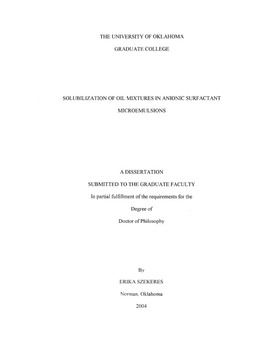| dc.contributor.advisor | Harwell, Jeffrey H., | en_US |
| dc.contributor.advisor | Knox, Robert C., | en_US |
| dc.contributor.author | Szekeres, Erika. | en_US |
| dc.date.accessioned | 2013-08-16T12:19:25Z | |
| dc.date.available | 2013-08-16T12:19:25Z | |
| dc.date.issued | 2004 | en_US |
| dc.identifier.uri | https://hdl.handle.net/11244/733 | |
| dc.description.abstract | Surfactant enhanced aquifer remediation technology offers great potential to clean up oil contaminants. For oil mixture contaminants the remediation efficiency can vary significantly between the different oil components. To understand this behavior binary oil mixture solubilization in saturated oil/water/anionic surfactant microemulsion systems has been studied, using dissimilar oil components. Phase behavior, solubilization, and interfacial tension studies have been carried out with three model oil mixtures: TCE-acetone, benzene---limonene, and dodecanol---limonene. In the TCE-acetone mixture acetone diluted the surfactant monolayer at the oil/water interface reducing its solubilization ability. The optimum salinity was not affected by acetone, due to balanced acetone partitioning between the oil and water phases. Benzene-limonene and dodecanol-limonene mixture studies suggest that the semi-polar benzene and amphiphilic dodecanol is solubilized selectively in the oil domain of the microemulsion, close to the oil/water interface. Selectivity decreases with increasing electrolyte concentration and with increasing polar oil concentration. The excess polar oil solubilization follows a Langmuirian type adsorption trend. Studies of the dodecanol-limonene system suggest that the amount of oil solubilized at the palisade layer changes the curvature and the bending rigidity of the surfactant film. This in turn affects the optimum salinity and the oil solubilization ability of the microemulsion. These results are used to extend the net-average curvature model to predict solubilization of oil mixtures in microemulsions. Study and model results are used to explain why significant differences in the SEAR remediation efficiency of individual oil components could occur when the oil contaminant is a complex oil mixture. | en_US |
| dc.format.extent | xxi, 289 leaves : | en_US |
| dc.subject | Engineering, Chemical. | en_US |
| dc.subject | Nonaqueous phase liquids. | en_US |
| dc.subject | Surface active agents. | en_US |
| dc.subject | Groundwater Pollution. | en_US |
| dc.subject | Solubilization. | en_US |
| dc.subject | Emulsions. | en_US |
| dc.title | Solubilization of oil mixtures in anionic surfactant microemulsions. | en_US |
| dc.type | Thesis | en_US |
| dc.thesis.degree | Ph.D. | en_US |
| dc.thesis.degreeDiscipline | School of Chemical, Biological and Materials Engineering | en_US |
| dc.note | Advisers: Jeffrey H. Harwell; Robert C. Knox. | en_US |
| dc.note | Source: Dissertation Abstracts International, Volume: 65-03, Section: B, page: 1437. | en_US |
| ou.identifier | (UMI)AAI3126141 | en_US |
| ou.group | College of Engineering::School of Chemical, Biological and Materials Engineering | |
